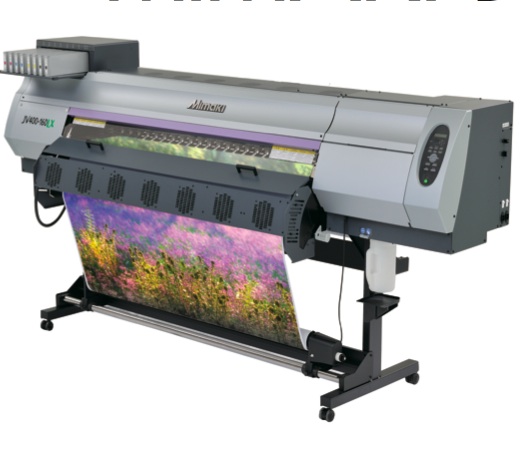Nessan Cleary reckons this new latex printer is likely to drive further take-up of this environmentally friendly inkjet technology.
One of the more exciting announce-ments from this year’s Fespa Digital show was Mimaki’s move into latex printing with its new JV400. This is built on a brand new chassis, developed as a platform for several new printers to come, including one using SUV inks that was announced at Fespa and will be launched later this summer.

In the meantime, Mimaki has started shipping the JV400 in the UK. It uses Mimaki’s own LX100 ink, an aqueous resin-based latex ink. All latex inks depend on a certain amount of heat, to help dissolve the resin, forming a membrane that bonds the pigments to the substrate.
The main advantage of the Mimaki approach is that it uses a piezo printhead so there’s a lot less heat, both for printing and curing, than the alternative HP with its thermal printhead, which uses 80 - 120ºC.
Duncan Jefferies, marketing manager for Hybrid, the UK distributor for Mimaki, explains: “We are curing the latex inks at temperatures around 40 - 60ºC so that opens up a lot of media that we can cure to.”
There are three heaters under the platen that heat the media before, during and after printing to maintain a constant temperature around the media. Thus, the ink is stable immediately after printing, though it can still be smudged. Finally, there’s a surface heater, which is set to be 20ºC hotter than the post-print heater, which cures the print so that it’s bone dry before it gets to the take-up roll. This is one of the great advantages of latex as there is no need to wait for gassing out so prints can be laminated and finished immediately after printing. They are rub and scratch resistant, as well as outdoor durable. There’s a good supply of suitable substrates thanks to HP’s efforts in this area. In addition it will print to standard vinyls as well as fabrics.
This is one of the first printers to use Ricoh’s new Gen5 piezo printheads. These deliver up to three different drop sizes right down to four picolitres leading to a very good image quality with sharp text even down to small point sizes. The JV400 uses two of these printheads, each with four rows of 320 nozzles, arranged in-line, giving four colour channels per head. The highest resolution is 1200 x 1200dpi, which runs at 11.9m2/hr, with the fastest speed being 18.1m2/hr at 900 x 900dpi.
There’s an option to use two sets of CMYK, or CMYKlclm, with or without white ink. Two channels are fitted to recirculate the ink, a necessity with all white inks to prevent the pigments clogging the nozzles. However, using white ink can slow the printer down, depending on your application, as Mike Horsten, Mimaki’s European marketing manager, explains: “White uses titanium oxide which is a big particle. We have to drop down a lot of particles to get a total opaque white so we have to drop down a lot of ink so the machine can slow down to 4.5m2/hr.”
But then the use of white ink does open up clear applications such as window graphics. To complement this there’s a new version of the Rasterlink 6 software which supports three layer graphics so that users can simultaneously print one layer of process colours, one of white and then a third of process colours allowing a double-sided window sign to be produced.
Rasterlink is a standard PostScript level 3 Rip, which is capable of driving up to four devices from a single PC. It has tight integration with Adobe Illustrator and has a neat feature for calculating the cost of a job based on the amount of ink to be used, once a job has been Ripped.
The JV400 is available in two sizes: there’s a 1.3m version, which costs £22,995; while the larger 1.6m wide model comes in at £24,995.

